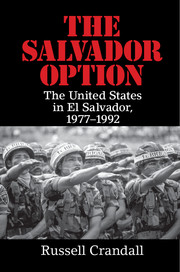Book contents
- Frontmatter
- Dedication
- Epigraph
- Contents
- List of Figures
- List of Organizations
- Acknowledgments
- 1 Introduction
- PART ONE EL SALVADOR IN THE COLD WAR
- 2 Farabundo Martí, La Matanza, and a Stolen Election
- 3 The United States in Latin America
- 4 American Military Mission in El Salvador
- 5 A Divided Nation: Military Traditions, Democratic Third Way, and Liberation Theology
- 6 Guerrillas Are Born
- PART TWO JIMMY CARTER
- PART THREE RONALD REAGAN
- PART FOUR GEORGE H. W. BUSH
- PART FIVE POSTWAR
- Notes
- Bibliography
- Index
4 - American Military Mission in El Salvador
from PART ONE - EL SALVADOR IN THE COLD WAR
Published online by Cambridge University Press: 05 June 2016
- Frontmatter
- Dedication
- Epigraph
- Contents
- List of Figures
- List of Organizations
- Acknowledgments
- 1 Introduction
- PART ONE EL SALVADOR IN THE COLD WAR
- 2 Farabundo Martí, La Matanza, and a Stolen Election
- 3 The United States in Latin America
- 4 American Military Mission in El Salvador
- 5 A Divided Nation: Military Traditions, Democratic Third Way, and Liberation Theology
- 6 Guerrillas Are Born
- PART TWO JIMMY CARTER
- PART THREE RONALD REAGAN
- PART FOUR GEORGE H. W. BUSH
- PART FIVE POSTWAR
- Notes
- Bibliography
- Index
Summary
“This Hemisphere Intends to Remain the Master of Its Own House”
It was perhaps inevitable that Cuba would be at the center of this dramatic scaling up of low impact counterinsurgency. A classified SECRET U.S government intelligence report published in 1961 highlighted the perception of Cuba's key role as an incubator for revolution in the region:
Castro's Cuba has become to much of the Latin American community a living example of the radical breakup of traditional social and economic patterns. For many of these who seek to upset the status quo in their own countries Havana has developed into the mecca of revolutionary inspiration and conspiracy.…Castro's shadow looms large because social and economic conditions throughout Latin America invite opposition to ruling authority and encourage agitation for radical change.
Indeed, by 1962 Cuba had become the primary source of manpower and resources for igniting insurgencies throughout the Western Hemisphere. As stated in a 1964 State Department report, “The primary danger we face in Castro is…the impact the very existence of his regime has upon the leftist movement in many Latin American countries.…The simple fact is that Castro represents a successful defiance of the U.S., a negation of our whole hemispheric policy of almost a century and a half.”
In principle, the core of the U.S. response to guerrilla insurgencies during the Cold War involved three wide-ranging objectives for “client” (or target) countries: democratization, economic development, and security. This three-pronged approach began during the Kennedy administration and endured as the primary model in U.S. policy, military doctrine, and practice, although U.S. responses at different times often emphasized one objective over the others. Most of the time security was the priority, but this is not to say that the pro-democracy and economic modernization goals were cut out of the picture.
The Kennedy administration believed that America's mission included robust support for democracy across the globe. Americans had to oppose the “powerful destructive forces…challenging the universal values that for centuries have inspired men of good will in all parts of the world.” The hallmark of Kennedy's “peace revolution” strategy was the Alliance for Progress, a planned 10-year program of massive economic investment and assistance to promote sorely needed political, social, and economic reform in Latin America.
- Type
- Chapter
- Information
- The Salvador OptionThe United States in El Salvador, 1977–1992, pp. 36 - 45Publisher: Cambridge University PressPrint publication year: 2016

